Our research focuses on understanding the effect of land-use and climate change on, and the ecological role of, communities – in both natural and urban ecosystems. Our primary goal is to help understand the importance of biotic communities to ecosystem function and service, but the majority of our research endeavors focus on amphibians and reptiles in aquatic and terrestrial ecosystems. Research in the Milanovich Lab is primarily field based; however, we utilize a number of computer-based and laboratory techniques, such as mark-recapture, species distribution models, ecological stoichiometry, and stable isotope analysis to study community and landscape-level interactions.
Examples of current research projects include:
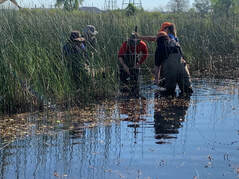
Heavy Metal Accumulation, Physiological and Spatial Ecology of Spotted Turtles
With funding from the Northern Indiana Public Service Company and Loyola University
Chicago, Jess Lindberg (graduate student), Marlen Terrazas (technician) and Dr. Leigh Anne
Harden (Benedictine University) are leading the way to conduct radio-telemetry and blood
physiology measures on two spotted turtle populations in northern Indiana.
With funding from the Northern Indiana Public Service Company and Loyola University
Chicago, Jess Lindberg (graduate student), Marlen Terrazas (technician) and Dr. Leigh Anne
Harden (Benedictine University) are leading the way to conduct radio-telemetry and blood
physiology measures on two spotted turtle populations in northern Indiana.

Survey for the Endangered Copperbelly Water Snake in Indiana
With funding from the Indiana Department of Natural Resources, we are pleased to conduct
an extensive survey for CWS in northern Indiana using a robust repeated-measure design to
locate these elusive snakes.
With funding from the Indiana Department of Natural Resources, we are pleased to conduct
an extensive survey for CWS in northern Indiana using a robust repeated-measure design to
locate these elusive snakes.
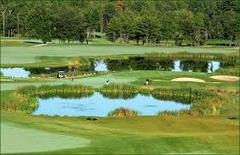
Golf Course Biodiversity Project
With the Berg Lab at LUC and the Urban Wildlife Institute at the Lincoln Park Zoo, we are
surveying a number of Midwestern golf courses to the effectiveness of pollinator gardens,
bat boxes, and additions of coarse woody debris on biodiversity of golf course ecosystems.
With the Berg Lab at LUC and the Urban Wildlife Institute at the Lincoln Park Zoo, we are
surveying a number of Midwestern golf courses to the effectiveness of pollinator gardens,
bat boxes, and additions of coarse woody debris on biodiversity of golf course ecosystems.
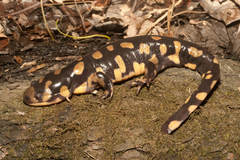
Saline salamanders in Canada
With the Phillips Lab at the Water Security Agency in Saskatchewan, Canada and the
Bystrainsky Lab at DePaul University, we are examining the physiological acclimation of
larval Tiger Salamanders in the pothole region of Saskatchewan, Canada.
With the Phillips Lab at the Water Security Agency in Saskatchewan, Canada and the
Bystrainsky Lab at DePaul University, we are examining the physiological acclimation of
larval Tiger Salamanders in the pothole region of Saskatchewan, Canada.
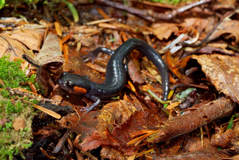
Impacts of wildfire and global climate change on lungless salamanders of Great Smoky
Mountains National Park
With colleagues from the National Great Rivers Research and Education Center, Ohio State
University and Frostburg State University we are investigating the impacts and influence of
wildfire and climate change on lungless salamanders populations.
Mountains National Park
With colleagues from the National Great Rivers Research and Education Center, Ohio State
University and Frostburg State University we are investigating the impacts and influence of
wildfire and climate change on lungless salamanders populations.
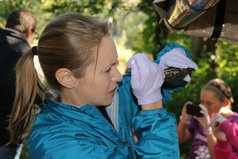
Assessing the influence of captive-rearing on Blanding's Turtle survival, health and physiology
Graduate student, Armand Cann (along with Drs. Harden and Milanovich) are currently
investigating the influence of captive-rearing methodologies on the health and physiology of
Blanding's Turtles post-release using aquatic trapping, radio-telemetry and blood chemistry
analysis. This project is currently in coordination with several programs across Illinois.
Graduate student, Armand Cann (along with Drs. Harden and Milanovich) are currently
investigating the influence of captive-rearing methodologies on the health and physiology of
Blanding's Turtles post-release using aquatic trapping, radio-telemetry and blood chemistry
analysis. This project is currently in coordination with several programs across Illinois.
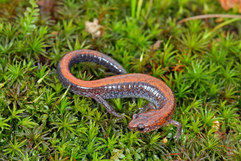
Examining the nutrient cycling and storage roles of a terrestrial salamander, Plethodon
cinereus
We have officially joined the SPARCnet survey crew and will be examining the population
sizes and role of terrestrial salamanders to ecosystems in northern Indiana. This project is in
coordination with SPARCnet collaborators and is funded by the National Great Rivers
Research and Education Center.
cinereus
We have officially joined the SPARCnet survey crew and will be examining the population
sizes and role of terrestrial salamanders to ecosystems in northern Indiana. This project is in
coordination with SPARCnet collaborators and is funded by the National Great Rivers
Research and Education Center.
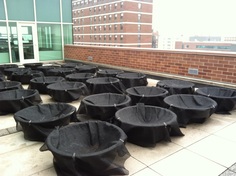
The synergistic impacts of invasive plants and climate change on larval and post-metamorphic amphibian fitness and stoichiometry
Using a set of replicated mesocosm experiments, we are investigating whether plant quatlity has measurable legacy effects on the ecology of anurans. The experimental set up at LUC (left) is located on the biology building roof-top patio adjacent to our Aquatic Simulation Laboratory. This work involves several undergraduates and is in collaboration with researchers from Clemson University, National Great Rivers Research and Education Center and DePaul University.
Using a set of replicated mesocosm experiments, we are investigating whether plant quatlity has measurable legacy effects on the ecology of anurans. The experimental set up at LUC (left) is located on the biology building roof-top patio adjacent to our Aquatic Simulation Laboratory. This work involves several undergraduates and is in collaboration with researchers from Clemson University, National Great Rivers Research and Education Center and DePaul University.
Examples of previous research projects include:
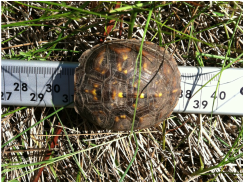
Examining the hibernaculum, home ranges, diet, stress and physiology of Ornate Box Turtles in northerm Illinois
With funding from the Illinois Department of Natural Resources, we examining the characteristics of hibernaculum, ecology, stress and physiology (blood chemistry) of Terrapene ornata at three sites in northern Illinois. This work involved several undergraudates at LUC.
With funding from the Illinois Department of Natural Resources, we examining the characteristics of hibernaculum, ecology, stress and physiology (blood chemistry) of Terrapene ornata at three sites in northern Illinois. This work involved several undergraudates at LUC.
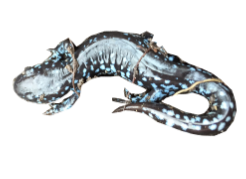
Quantifying the factors that shape food webs and alter suitable habitat of taxa in Midwestern wetland ecosystems
Led by Brock Struecker, our lab investigated the food web structure and impact of urbanization and invasive species on wetland ecosystems in Lake County, Illinois. Brock also predicted the impact of global climate change on the suitable climatic habitat of the top predators in Midwestern wetlands......pond-breeding salamanders!
Led by Brock Struecker, our lab investigated the food web structure and impact of urbanization and invasive species on wetland ecosystems in Lake County, Illinois. Brock also predicted the impact of global climate change on the suitable climatic habitat of the top predators in Midwestern wetlands......pond-breeding salamanders!
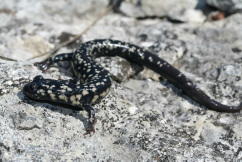
Plethodontids importance, or not, to nutrient dynamics in forested ecosystems
In collaboration with Dr. Bill Peterman from the Illinois Natural History Survey, we
quantified the standing stock of nutrients within terrestrial salamanders at a conservation
area in Missouri. We hope this work can be used to compare previous estimates of standing
stock within other vertebrates and basal nutrient sources.
In collaboration with Dr. Bill Peterman from the Illinois Natural History Survey, we
quantified the standing stock of nutrients within terrestrial salamanders at a conservation
area in Missouri. We hope this work can be used to compare previous estimates of standing
stock within other vertebrates and basal nutrient sources.
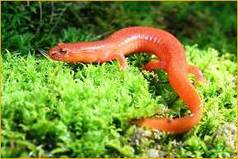
Investigating nutrient recycling and storage of stream salamanders in headwater streams.
In collaboration with Dr. John Maerz (Univ. Georgia), Dr. Amy Rosemond (Univ. Georgia) and Dr. Matt Hopton (U.S. EPA) we examined the role larval stream salamanders play in the storage and recycling of N and P in headwater streams in the Midwest and southeastern United States.
In collaboration with Dr. John Maerz (Univ. Georgia), Dr. Amy Rosemond (Univ. Georgia) and Dr. Matt Hopton (U.S. EPA) we examined the role larval stream salamanders play in the storage and recycling of N and P in headwater streams in the Midwest and southeastern United States.
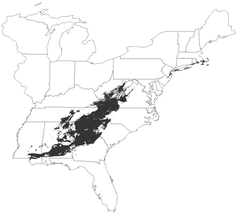
Using species distribution models to predict the impact of global change on amphibians.
With collaborators from several universities and government agencies, we have modeled the predicted effects of global climate change and landscape-change on amphibian distributions. This work has showed global climate change could significantly alter the distributions of plethodontid salamanders in the southeastern United States and that these models can be used to predict areas of higher amphibian species richness in heterogeneous landscapes.
With collaborators from several universities and government agencies, we have modeled the predicted effects of global climate change and landscape-change on amphibian distributions. This work has showed global climate change could significantly alter the distributions of plethodontid salamanders in the southeastern United States and that these models can be used to predict areas of higher amphibian species richness in heterogeneous landscapes.
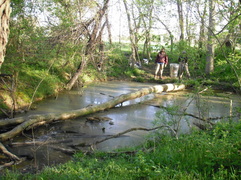
Examining the influence of urbanization on amphibians and macroinvertebrates in wetlands.
Dr. Milanovich, along with collaborators from U.S. EPA and Xavier University, quantified the amphibian and macroinvertebrate communities in urban and less-urban areas in southwest Ohio. This work involved several undergraduate students from Xavier University.
Dr. Milanovich, along with collaborators from U.S. EPA and Xavier University, quantified the amphibian and macroinvertebrate communities in urban and less-urban areas in southwest Ohio. This work involved several undergraduate students from Xavier University.
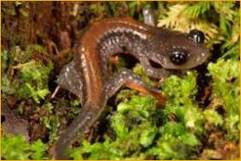
Investigating the use of stable isotopes in herpetological research.
This work along side Dr. John Maerz (Univ. Georgia) showed non-lethal tail clips can be used to measure stable isotope values of salamanders. We also found fasting in terrestrial salamanders does not have a measurable impact on stable isotope compositions.
This work along side Dr. John Maerz (Univ. Georgia) showed non-lethal tail clips can be used to measure stable isotope values of salamanders. We also found fasting in terrestrial salamanders does not have a measurable impact on stable isotope compositions.

